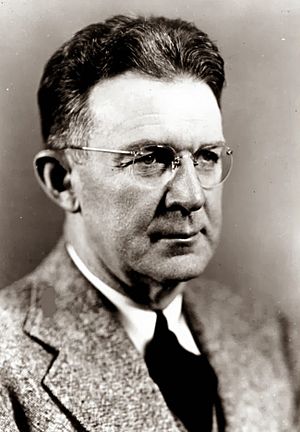B. Frank Heintzleman facts for kids
Quick facts for kids
B. Frank Heintzleman
|
|
|---|---|
 |
|
| 8th Governor of Alaska Territory | |
| In office April 10, 1953 – January 4, 1957 |
|
| Nominated by | Dwight D. Eisenhower |
| Preceded by | Ernest Gruening |
| Succeeded by | Waino Edward Hendrickson Territorial Acting Governor of Alaska |
| Personal details | |
| Born |
Benjamin Franklin Heintzleman
December 3, 1888 Fayetteville, Pennsylvania |
| Died | June 24, 1965 (aged 76) Juneau, Alaska |
| Political party | Republican |
Benjamin Franklin Heintzleman (born December 3, 1888 – died June 24, 1965) was an American expert in forests. He spent much of his life helping to develop the Alaska Territory. After working for the United States Forest Service, he became the Governor of the Alaska Territory. He served as governor from 1953 to 1957. As governor, he continued to support Alaska's economy. However, he was mostly against Alaska becoming a state at that time.
Contents
Early Life and Forestry Career
Heintzleman was born in Fayetteville, Pennsylvania, on December 3, 1888. His parents were Andrew J. and Rebecca Jane Heintzleman. He went to public schools. Later, he studied forestry at the Pennsylvania State College. He earned a Bachelor's degree in forestry in 1907. In 1910, he received a Master's degree in forestry from Yale University.
Working with Forests
Soon after college, Heintzleman joined the United States Forest Service. He worked in Oregon and Washington. When the United States joined World War I, he moved to Alaska. His job was to manage lumber production there. From 1918 to 1934, he was an Assistant Regional Forester in Ketchikan, Alaska.
In this role, he helped grow the region's pulp and lumber industries. He was important in building two pulp mills in southeast Alaska. During this time, he wrote a report called "The Forests of Alaska" in 1921.
In 1934, Heintzleman led forest conservation for the National Recovery Administration. This was a government program to help the economy. In 1937, he became Alaska's representative for the Federal Power Commission. This group manages energy projects. The same year, he was promoted to Regional Forester for Alaska. He held this important job until 1953. He also served as Alaska's Commissioner of the United States Department of Agriculture. He encouraged more lumber and pulp mills. He also supported other industrial growth. From 1939 to 1940, he led the Alaska Territorial Planning Board.
Becoming Governor of Alaska
President Dwight D. Eisenhower chose Heintzleman to be the Governor of Alaska Territory. This happened on March 11, 1953. After the government approved him, he started his term on April 10, 1953.
Governor's Main Goals
The new governor's main goal was to help Alaska's economy grow. He wanted to change laws about homesteading and land. Homesteading allowed people to claim and settle on land. He also wanted new rules for mining leases, power licenses, and timber contracts.
Heintzleman worked with Hawaiian Territorial Governor Samuel Wilder King. They both asked for a 25-year tax holiday. This meant businesses would not pay taxes for 25 years. They hoped this would bring more industries to Alaska and Hawaii.
Heintzleman also disagreed with Native claims to millions of acres of land. He wanted this land to be open for development. This led to a long legal fight in the United States Court of Claims.
Leaving Office
Heintzleman resigned as governor on December 18, 1956. He wrote that he had worked for the public for 46 years. He wanted to retire and do "less strenuous work." He resigned three months before his term ended. He wanted his replacement to be ready before the next territorial legislature met. His resignation became official on January 4, 1957. The Territorial Secretary became the Acting Governor. A new permanent governor was named later in May 1957.
His Views on Statehood
A big political issue in Alaska was whether it should become a state. Heintzleman's ideas about this changed over time. When he first became governor, he thought Alaska was "a little premature" to become a state.
After a year, he changed his mind. He suggested dividing the territory. He thought the southern and eastern parts, where most people lived, should become a state. Heintzleman explained his idea in a letter on April 3, 1954. He wrote to Speaker Joseph W. Martin Jr..
He proposed a border starting at the Alaska-Yukon line. It would follow the Brooks Range and then the 152nd meridian west. It would go to the Gulf of Alaska and include Kodiak Island. This eastern area included Anchorage, Fairbanks, and the Alaska Panhandle. About 85% of Alaska's population lived there. Heintzleman believed this part should become a state. The northern and western parts, which were mostly unsettled, would remain a territory.
This idea to divide Alaska was very unpopular. People in Alaska started a petition. They asked President Eisenhower to remove Heintzleman as governor.
By 1956, Heintzleman no longer opposed statehood. He supported creating a state constitution. A constitution is a set of rules for how a state is governed. Heintzleman signed the bill that created the Alaska Constitutional Convention. This meeting helped write Alaska's constitution.
Life After Being Governor
From 1957 to 1959, Heintzleman was a member of the University of Alaska Board of Regents. This board helps manage the university. In 1960, he advised the Alaska Rail and Highway Commission.
Heintzleman died from a heart attack on June 24, 1965, in Juneau, Alaska. He was buried in Chambersburg, Pennsylvania. A geographic feature north of Juneau, Heintzleman Ridge, was named after him in 1966. This was done to remember him.

